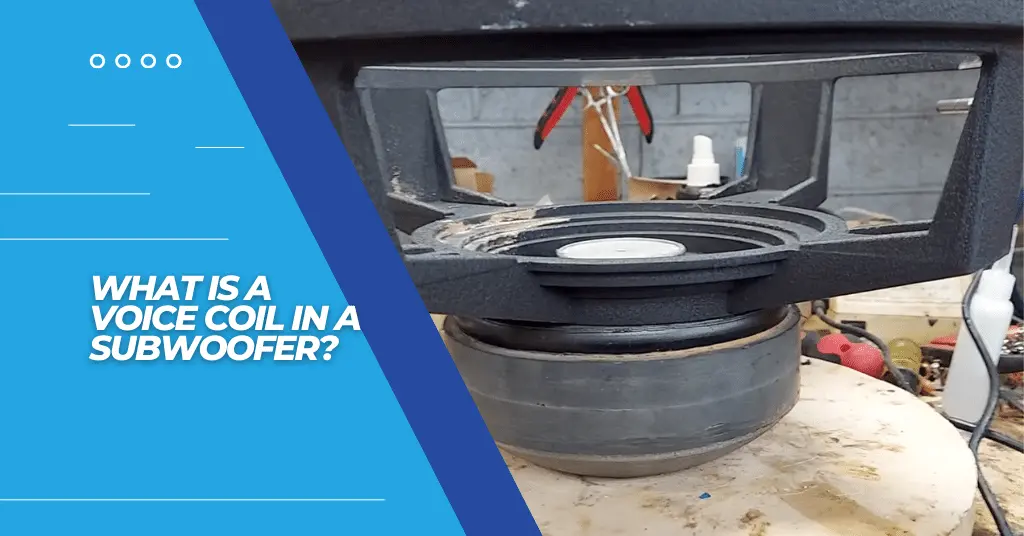What Is a Voice Coil in a Subwoofer?

Have you ever wondered what makes a subwoofer work? The answer lies in the voice coil. A voice coil is an essential component of any loudspeaker, and it’s necessary for subwoofers because they produce low-frequency sounds.
A subwoofer voice coil consists of two main parts: the former and the latter. The former is typically made of copper wire and works as an electrical conductor that carries electric current to create sound waves. It is wound around a cylindrical bobbin, which can be made from materials such as aluminum or ferrite.
What Is Subwoofer?
A subwoofer is a specialized loudspeaker explicitly designed for reproducing low-frequency sound. It consists of a significant speaker driver, an enclosure or cabinet to house it, and an amplifier to power the speaker.
The primary purpose of the subwoofer is to accurately reproduce low frequencies such as 20Hz – 200Hz or lower, providing music, movies, and other content with deep bass tones and adding depth and impact to the audio experience.
Subwoofers are commonly used in home theaters, car audio systems, professional sound systems, and personal audio setups because they enhance overall sound quality.
Their size can vary from compact units for personal use to larger ones used in professional settings that require more powerful bass output.
How Does a Voice Coil Work in a Subwoofer?
As I have mentioned earlier, voice coils are an integral and essential part of subwoofers, enabling them to produce deep and powerful bass.
They function by converting electrical signals into mechanical motion through the interaction between a coil of wire and a magnetic field.
The cylindrical bobbin generates a magnetic field when an electric current passes through the voice coil. This magnetic field interacts with the permanent magnet in the subwoofer, resulting in vibrations that produce sound waves through the attached speaker cone.
Simultaneously, the latter part of the voice coil operates similarly but utilizes different materials, such as plastic or Kapton tape, instead of copper wire.
This component also contributes to generating electromagnetic fields, assisting in controlling power distribution to each speaker cone.
This control allows users to customize their listening experience according to their preferences. Though, you can adjust the frequency and amplitude of the sound produced by a subwoofer by altering the electrical signal sent to its voice coil.
This capability allows the subwoofer to reproduce various frequencies, including low-frequency bass sounds, accurately.
Types of Voice Coil:
There is a huge difference between single and dual voice coil subwoofer. There are two main types of subwoofer voice coil: single and dual voice coil:
1. Single Voice Coil (SVC):
A single voice coil (SVC) is a coil configuration commonly found in subwoofers. It indicates there is only one coil of wire wound around a cylindrical former within the subwoofer’s magnetic structure.
The single voice coil design simplifies the wiring process as it requires connecting the amplifier to only one set of terminals on the subwoofer. This also makes it an ideal choice for entry-level or basic models since they are typically cheaper and easier to install.
However, one major limitation with SVCs compared to other configurations like dual voice coils (DVC) is their fixed impedance rating, usually 2 or 4 ohms, determining how much electrical load they present to the amplifier.
Matching this impedance correctly with your chosen amplifier and a speaker system can help ensure optimal performance from your system by providing proper power delivery.
If you are using an SVC in your audio setup, then you should pay special attention when making sure all connections are correct and that any wires are adequately insulated from each other to avoid any shorts which could damage speakers or amplifiers and lead to potential safety hazards such as electric shocks.
Additionally, ensure you use appropriate cables with sufficient length when running them between components so that impedances stay within the desired range.
These precautions can help you get the most out of your single-voice coil configuration and enjoy sound quality for many years.
2. Dual Voice Coil (DVC):
Dual Voice Coil (DVC) is an advanced type of coil configuration used in subwoofers. It features two separate coils wound around a shared cylindrical former, and each coil has its own set of terminals for greater wiring flexibility.
Wiring options include series, parallel, or independent wiring configurations. The advantages of a dual voice coil configuration are numerous.
For one, it allows for different impedance levels to be connected to the subwoofer depending on the desired audio system setup.
This provides more compatibility with various amplifiers and audio systems than single voice coils can offer. Additionally, it gives more control over the performance as both coils can be utilized effectively for higher power handling capabilities and enhanced bass output compared to conventional models with only one coil present.
Dual voice coil subwoofers also offer far greater customization potential when setting up a stereo or multi-channel audio system since numerous combinations are available when connecting multiple speaker systems via the dual drivers found in DVC sub-lovers.
Lastly, it also allows you to adjust wattage when using oppositely wound coils. It adds another layer of tuning required for a maximum bass response without sacrificing sound quality or clarity within all listener’s the preferred frequency range controls and SPL adjustment curves.
Importance of a High-Quality Voice Coil in a Subwoofer:
When it comes to getting the most out of your subwoofer, you must always go for a high-quality voice coil. A quality voice coil helps ensure that your subwoofer produces clear and powerful sound at all frequencies. Look at some of the factors for why you should go for a good-material coil:
1. Enhanced Sound Accuracy and Precision:
Low-quality voice coils can be prone to noise and distortion, mainly due to their higher impedance levels. This can adversely affect the overall sound accuracy, especially in reproducing low frequencies.
On the other hand, high-quality voice coils employ components such as neodymium magnets to optimize power transfer while minimizing heat build-up within the coil itself. This allows for more precise signal translation and improved accuracy compared to lower-grade materials.
Furthermore, voice coils with high-temperature resistant coatings ensure stability during extended usage, safeguarding against damage caused by heat generated when operating at higher volume levels or in conjunction with a subwoofer amplifier designed for rich bass tones.
With advanced materials and precise winding tolerances, high-quality voice coils offer enhanced responsiveness across the entire audible frequency spectrum.
2. Increased Power Handling and Efficiency:
Moreover, a high-quality voice coil contributes to superior sound quality and power handling capacity. It is constructed with a thicker voice coil wire, enhancing both the current carrying capacity and the ability to handle higher power levels associated with amplified music.
Modern voice coils utilize powerful magnets that offer better control over the cone’s movement, resulting in more accurate bass tones even at louder volumes.
Furthermore, a well-constructed voice coil efficiently dissipates heat, reducing the risk of thermal impedance or damage caused by prolonged use at excessive temperatures.
The increased power handling capacity enables the subwoofer to deliver louder and clearer ultra-low-frequency output, enhancing the audio experience compared to standard speakers.
In summary, a high-quality coil provides users with superior sound quality and durability performance, allowing for extended periods of high-power operation without the risk of damage.
3. Improved Durability and Longevity:
As mentioned above, good-quality voice coils are built with durable materials and advanced construction techniques, which provides increased reliability and longer life.
Unlike poor voice coils, these voice coils are designed to be robust, with the ability to withstand high mechanical pressure and extended usage.
The materials used in their construction provide excellent temperature stability and electrical resistance, preventing breakdowns from shock when amplifying sound signals.
Additionally, these materials offer superior linearity and frequency response performance by providing an extended bass range.
With a robust build quality that delivers consistent movement over time, a well-engineered voice coil can endure years of heavy use without compromising its smooth operation or sound quality.
4. Consistent Performance and Stability:
A high-quality voice coil is vital in ensuring consistent performance over time. Precise manufacturing techniques guarantee stable and reliable operation of the subwoofer.
The coil’s stability minimizes variations in sound quality, enabling accurate bass reproduction and maintaining consistency in the audio output.
A robust magnetic structure within the voice coil reduces distortion, eliminates the risk of mechanical failure, improves self-damping properties by minimizing inductance variation, and enhances linear excursion capabilities.
These characteristics enable the subwoofer to handle higher power levels efficiently, making a well-made product an invaluable asset when seeking an efficient solution.
5. Compatibility and Flexibility:
A high-quality coil offers compatibility with a wide range of audio systems, providing flexibility regarding installation options and integration into different setups.
The primary advantage of a versatile voice coil lies in its ability to adapt to diverse audio requirements. Its capability to seamlessly integrate into famous home or car audio systems while maintaining optimal sound reproduction makes it an ideal choice for your setup.
Furthermore, advanced models of voice coils provide superior power handling capabilities compared to most other speaker designs, resulting in reduced distortion at all levels.
This allows for extracting finer details from your music or movies and delivers a crisp sound with enhanced clarity. In summary, installing a subwoofer with a high-quality voice coil ensures superior performance regardless of compatibility issues or preferred setup options.
How Does Voice Coil Diameter Affect the Bass?
The diameter of the voice coil in a subwoofer significantly impacts its bass performance. A larger voice coil size allows for more excellent excursion capability, enabling the speaker cone to move with increased power and amplitude.
This leads to enhanced low-frequency output that is louder and more impactful. Furthermore, a larger voice coil diameter facilitates efficient power handling by the subwoofer.
Moreover, a larger voice coil size promotes better heat dissipation when dealing with high power levels. The increased surface area of the voice coil helps dissipate heat, protecting the subwoofer from overheating and potential damage during prolonged use.
While a larger voice coil diameter is beneficial for bass performance, you should note that it is not the sole determining factor. Other factors, such as the enclosure design, cone material quality, and power amplifier, also significantly contribute to the overall sound quality.
In summary, a larger voice coil diameter in a subwoofer improves excursion capability, power handling, and heat dissipation, resulting in a more powerful bass response.
However, achieving optimal bass performance requires considering all aspects of the subwoofer as part of a well-integrated design.
General FAQs
What Is the Function of the Voice Coil?
The voice coil is an element of a speaker that converts electrical signals into sound. It consists of a wire coil placed in the gap between the magnet and pole piece, and when an audio signal is applied to it, the magnetic field around it causes it to vibrate, creating sound waves.
Is It Better to Have a Bigger Voice Coil?
Yes, having a bigger voice coil generally results in better sound quality. It can help improve the accuracy and clarity of sound, provide more power output capabilities, and more excellent dynamics. It also helps to reduce distortion at high volume levels.
Does the Power Handling of a Voice Coil Matter?
Yes, a voice coil’s power handling is essential to ensure it is not damaged due to excessive power input. It determines the power that can be safely sent through the coil without any damage. Higher power handling allows higher output levels and better performance.
